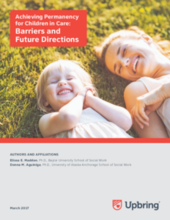Executive Summary
While permanency is a federally legislated goal for children in out-of-home care, many children do not achieve a permanent placement in a timely manner, if at all. A multitude of factors impact the likelihood that a permanent placement will be attained for a child in care.
- System-level factors that act as a barrier to permanency include problems in recruiting and retaining prospective foster and adoptive families, high caseloads and turnover among child welfare workers, inadequate resources to assist families, and an overcrowded court system.
- Case-level factors that may inhibit a child’s likelihood of obtaining a permanent home are prior removal history, placement stability, initial placement, and reason for removal.
- Child and family level factors that impact permanency outcomes include demographic characteristics (e.g., gender, age, race/ ethnicity), physical and mental disabilities, and parental substance use and mental health.
This paper reviews these factors in greater depth, as well as several programs and initiatives implemented to support positive permanency outcomes.

